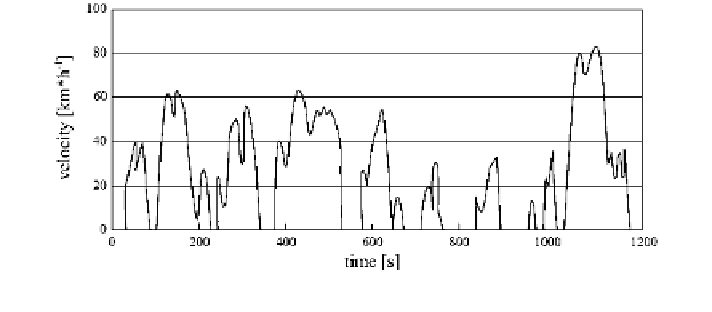Environmental Engineering Reference
In-Depth Information
Fig. 12.4
Japanese Driving Cycle JC 08 for passenger cars Luca Gray (08/12/11)
Emissions of heavy-duty vehicles are tested in the USA at a roller test bench
with specific dynamometer transient driving cycles for HDVs. The methods in the
USA are similar to the European Cycles in principle, but have a different specific
speed profile and specify different gears [
8
].
12.1.2.3 Procedures in Japan
In Japan, there are old driving cycles such as the Japanese 11 and Japanese
10 ? 15 modes [
9
], and new cycles such as the Japanese Cycle JC 08 for pas-
senger cars and Japanese Cycle JE 05 for heavy commercial vehicles [
10
,
11
].
The length of 11 mode cold cycle is 4.084 km and the time is 480 s. It involves
60 km h
-1
,
a
maximum
speed
of
i.e.,
37.3 mph
and
an
average
speed
of
30.6 km h
-1
, i.e., 18.6 mph.
The 10 ? 15 mode is a hot cycle. The driving time is 892 s; the distance is
6.34 km, i.e., 3.94 mi, the average speed is 25.61 km h
-1
, i.e., 15.9 mph; and the
maximum speed is 70 km h
-1
, i.e., 43.5 mph. Emissions are measured in the last
four segments over 4.16 km, i.e., 2.6 mi in the time interval of 600 s.
The Driving Cycle JC 08 is measured over a distance of 8.2 km, i.e., 5.1 mi,
and a time of 1,205 s at an average speed of 24.4 km h
-1
, i.e., 15.2 mph with a
maximum speed of 80 km h
-1
, i.e., 49.7 mph (see Fig.
12.4
).
12.1.3 Heavy Duty Vehicles
The control cycles are different in the EU, the USA, and Japan, similarly to the
passenger car control methods. However, there are harmonized test cycles which
are based on world-wide pattern of real heavy commercial vehicle use. Two
representative cycles, a transient test cycle (WHTC) with both cold and hot start
requirements and a hot start steady-state test cycle (WHSC) belong to the cycle.
The test time of WHTC is 1,800 s with several monitoring segments [
12
].

Search WWH ::

Custom Search